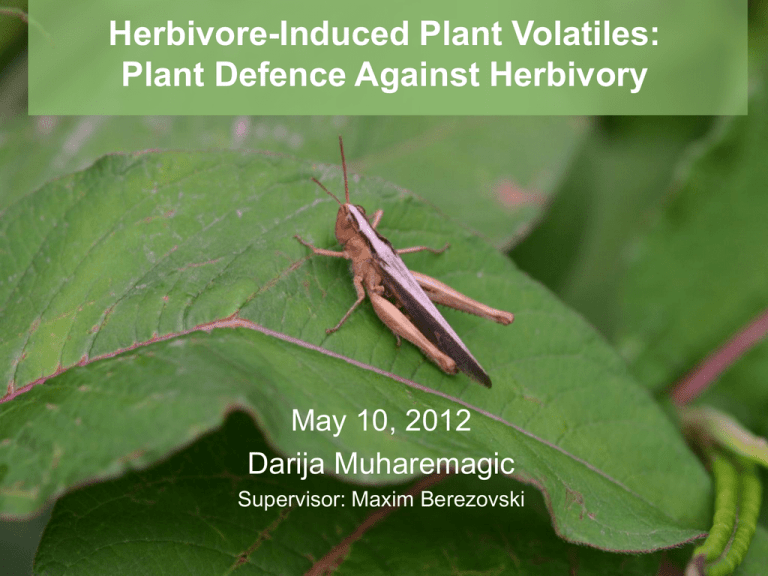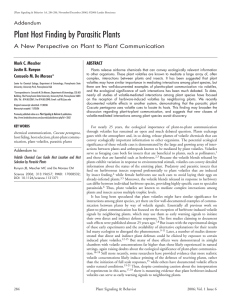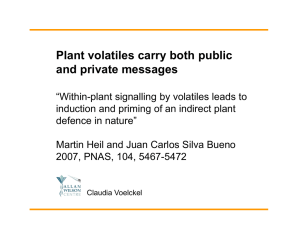Herbivore-Induced Plant Volatiles
advertisement

Herbivore-Induced Plant Volatiles: Plant Defence Against Herbivory May 10, 2012 Darija Muharemagic Supervisor: Maxim Berezovski Outline • Introduction to plant volatiles – Biosynthetic pathways – Functions • Plant defence – Stimuli – Jasmonate signalling • Integrated pest management – Synthesis of methyl jasmonate • Conclusion 2 Fight-or-flight response 3 Plant volatiles • Volatile organic compounds released by plants – 1000 tera-grams of carbon per year for terpenoids – e.g. essential oil in rose petals ~0.02–0.03% of plant’s weight Qualley, A. and Dudareva, N. 2010. Plant Volatiles. eLS. 4 Plant volatiles • Complex variety of volatile chemicals – Essential oils, etheral oils or essences • Numerous organic structures – Saturated and unsaturated hydrocarbons – Esters, aldehydes, ketones and amines • Secondary metabolites – No assigned role in growth, development or reproduction • Numerous functions – In plants – For mankind Qualley, A. and Dudareva, N. 2010. Plant Volatiles. eLS. 5 Network of interactions 6 Categories of PVOCs Sulfides, indoles and amines Aliphatics and aromatics 7 Volatile sulfides, indoles and amines • Garlic-released volatile • Allicin – Antimicrobial, insecticide – Inhibit blood clotting and lower blood pressure 8 Volatile aliphatics and aromatics • Great esthetical and commercial importance – Distinctive odours associated with fruits and flowers • Primary ecological function as pollinator attractants in flowers 9 Biosynthesis of plant volatiles: Amino acid-derived volatiles • Catabolism of branched chain amino acids gives rise to constituents of banana, apple, strawberry and tomato aromas. Kochevenko, A., Araújo, W.L., Maloney, G.S., Tieman, D.M., Do, P.T., Taylor, M.G., Klee, H.J. & Fernie, A.R Mol Plant. 2012 Mar;5(2):366-75. Epub 2011 10 Biosynthesis of plant volatiles: Terpenes • Responsible for several characteristic odours – Citrus, mint and conifers • Nonspecific toxins – Plant pathogens – Insects – Growth inhibition of competing plants • Formed by two or more isoprenes 11 Biosynthesis of plant volatiles: Isoprenes (terpene building blocks) Roberts SC. Nature Chemical Biology 3, 387 - 395 (2007) 12 Biosynthesis of plant volatiles: Fatty acid-derived plant volatiles • Originate from C18 unsaturated fatty acids Hans Weber. Trends in plant science. Volume 7, Issue 5, 1 May 2002, Pages 217-224 13 Biosynthesis of plant volatiles: Phenylpropanoids Qualley AV, Dudareva N, Methods Mol Bio. 2009;553:329-43 14 Plant volatiles • Generalized pathways for the synthesis of plant volatiles – Deterring predators and attracting pollinators Qualley, A. and Dudareva, N. 2010. Plant Volatiles. eLS. 15 Pollinators and volatiles • Plant emits volatiles to attract pollinators • Orchid Ophrys sphegodes – Solitary bee species Andrena nigroaenea – Flower mimics appearance and odours of a female bee – After pollination, compounds of non-receptive bees F.P Schiestl, M Ayasse, H.F Paulus, C Lofstedt, B.S Hansson, F Ibarra, W Francke, Nature, 399 (1999), pp. 421–422 16 Plant defences • Constitutive defence – Physical and chemical barriers • Peptides, cellulose, lignin, cuticular waxes, toxins • Induced defence – Up-regulation of constitutively synthesized compounds – De novo compound synthesis 17 Response induction by herbivores 18 ‘Cry for help’ • >25 predator species are known to be attracted to HIPVs • Herbivorous attack – Induction of volatiles – Attraction of carnivorous insects that prey on herbivores 19 Response induction ‘If you know your enemies and know yourself, you can win a hundred battles without a single loss’ Sun Tzu, The Art of War Volatile emission stimuli Mechanical Oral secretion Oviposition Walking 20 Response induction: Mechanical • Effect on lima bean leaves • MecWorm for mechanical treatment of leaves • Comparison of 4 volatiles from different biosynthetic pathways – Varying time of treatment – Varying area of damage • Pattern wheel and razor blade did not induce any substantial volatile emission Mithöfer, A., Wanner, G. & Boland, W. Plant Physiology 137 (3): 1160–8 21 Response induction: Mechanical Time (h) and area (mm2) treated 2.9 hours 313 mm2 Mithöfer, A., Wanner, G. & Boland, W. 2005, Plant Physiology 137 (3): 1160–8 16 hours 313 mm2 16 hours 733 mm2 22 Response induction: Oviposition • Spotted stemborer, a major pest of maize • Volatiles induced by oviposition – Attraction of egg and larval parasitoids Tamiru, A., Bruce, T.J.A., Woodcock, C.M., Caulfield, J.C., Midega, C.A.O., Ogol, C.K.P.O., Mayon, P., Birkett, M.A., Pickett, J.A. & Khan, Z.R. , Ecology Letters, (2011) 14: 1075–1083 23 Response induction: Oviposition • Attraction of egg and larval parasitoids – Leaves with egg deposition – Leaves from the same plant without egg deposition – Treatment with adhesive substance underneath eggs • Attraction of parasitoids to DMNT and TMTT, as well as caryophyllene at higher doses Tamiru, A., Bruce, T.J.A., Woodcock, C.M., Caulfield, J.C., Midega, C.A.O., Ogol, C.K.P.O., Mayon, P., Birkett, M.A., Pickett, J.A. & Khan, Z.R. , Ecology Letters, (2011) 14: 1075–1083 24 Jasmonate pathway • Biosynthesis of jasmonic acid Schaller F, SchallerA,Stintzi A Biosynthesis and Metabolism of Jasmonates J Plant Growth Regul (2005) 23:179–199 25 Jasmonate pathway: wound response • Proteinase inhibitors – Insects: proteolytic digestion of proteins – Defence against proteolytic enzymes • Localized cell death – Defence against biotic challenges – Limiting spread of infection • Jasmonate-derived compounds – Defence against herbivory – Plant communication 26 Jasmonate-Isoleucine • JA activation upon specific conjugation to isoleucine • JA metabolite with known molecular mechanism of action • JA-Ile functions by relieving repression of genes involved in jasmonate response 27 Reception of JA-Ile • Jasmonate ZIM domain (JAZ) protein represses transcription of jasmonate-response genes by binding to MYC2 transcription factor Pauwels, L. & Goossens, A. 2011, Plant Cell, vol. 23, no. 9, pp. 3089-3100. 28 Reception of JA-Ile • Jasmonate-isoleucine recruits JAZ to SCFCOI1 complex Pauwels, L. & Goossens, A. 2011, Plant Cell, vol. 23, no. 9, pp. 3089-3100. 29 Reception of JA-Ile • Poly-ubiquitylation in presence of JA-Ile Pauwels, L. & Goossens, A. 2011, Plant Cell, vol. 23, no. 9, pp. 3089-3100. 30 Reception of JA-Ile • Poly-ubiquitylated JAZ • Degradation • Results in expression of jasmonate-responsive genes Pauwels, L. & Goossens, A. 2011, Plant Cell, vol. 23, no. 9, pp. 3089-3100. 31 Methyl Jasmonate (MeJA) • Volatile JA derivative • Induces synthesis of protease inhibitors • Induces accumulation of other chemicals involved in plant defence – Sagebrush releases MeJA • Tomato plants in proximity synthesize PIs • Potential in pest management – Low concentrations Farmer, E.E. & Ryan, C.A. 1990, Proceedings of the National Academy of Sciences of the United States of America, vol. 87, no. 19, pp. 7717-77 32 Integrated pest management • Persimmon trees infested by Japanese wax scales • Ladybeetle is a natural predator of Japanese wax scales • Persimmon trees produce volatiles induced by MeJA Zhang, Y., Xie, Y., Xue, J., Peng, G. & Wang, X. 2009, Environmental Entomol 33 Integrated pest management • Tested ladybeetle attraction to different groups – Scale-infested group – MeJA-treated group • Ladybeetle response similar for scale-infested and MeJA-treated groups • Total of 23 volatile chemical compounds detected in these groups (9 terpenoids, α-pinene being the most abundant) Zhang, Y., Xie, Y., Xue, J., Peng, G. & Wang, X. 2009, Environmental Entomol 34 Total synthesis of methyl jasmonate • (-)-Methyl jasmonate – Stereogenic centers 35 Synthesis of methyl jasmonate • 83% ee • Ethyl and isopropyl substituents on the ligand gave the best enantioselectivity TAKEDA, H., WATANABE, H. and NAKADA, M., 2006. Tetrahedron, 62(34), pp. 8054-8063. 36 Synthesis of methyl jasmonate TAKEDA, H., WATANABE, H. and NAKADA, M., 2006. Tetrahedron, 62(34), pp. 8054-8063. 37 Conclusion • Plants use sophisticated mechanisms to overcome stresses • Production of volatile organic compounds – Various metabolic pathways – Array of chemical structures • Protection against herbivores – Jasmonate and its derivatives – Integrated pest management 38 Acknowledgements Berezovski Lab Special thank you to Dr. Durst and Christine Choueiri 39 Thank you! 40











